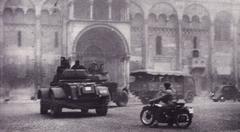Visiting Hours, Tickets, and History of Anfiteatro Romano in Arezzo, Italy
Date: 24/07/2024
Introduction
Nestled in the heart of Tuscany, Italy, Arezzo is a city rich in history and culture, offering visitors a unique blend of ancient and modern attractions. One of its most remarkable historical sites is the Anfiteatro Romano, an ancient Roman amphitheater that stands as a testament to the grandeur of the Roman Empire. Constructed in the 1st century AD, the amphitheater could hold between 8,000 to 10,000 spectators and served as a hub for gladiatorial games and public spectacles (It’s Tuscany). Today, it remains a significant relic of Roman engineering and social life, drawing history enthusiasts and casual travelers alike.
This comprehensive guide aims to provide all the essential information for anyone planning to visit the Anfiteatro Romano. From its historical significance and architectural features to practical visitor tips, this guide will cover everything you need to know. We’ll explore the best times to visit, ticket prices, and how to get there, along with nearby attractions that make Arezzo a must-visit destination. Whether you’re interested in ancient history, stunning architecture, or simply looking for a unique travel experience, the Anfiteatro Romano in Arezzo has something to offer for everyone.
Table of Contents
- Introduction
- History and Cultural Significance
- Architectural Features
- Visitor Information
- Visitor Tips
- Nearby Attractions
- Dining and Refreshments
- Safety and Etiquette
- FAQ
- Conclusion
History and Cultural Significance
The Anfiteatro Romano, built in the 1st century AD, is a marvel of ancient engineering. Constructed with sandstone and bricks, it could hold between 8,000 to 10,000 spectators and features an elliptical shape with bleachers on two orders and a large arena. This structure played a significant role in the social and cultural life of Roman Arezzo, hosting gladiatorial games and other public spectacles (It’s Tuscany). The adjacent National Archaeological Museum houses artifacts from the Etruscan and Roman periods, displayed across 26 galleries on two floors. Highlights include jewelry from the urban necropolis of Poggio del Sole, ceramics, glassware, bronzes, and numismatics (Discover Arezzo).
Architectural Features
The amphitheatre’s dimensions are remarkable, with an external measurement of approximately 120 meters along its major axis and nearly 70 meters along the minor one. The primary construction materials included sandstone, complemented by marble and bricks. The structure featured seating areas and a tribune consisting of two tiers. To facilitate access and the movement of spectators, a corridor encircled the central arena, along with two covered passageways beneath the bleachers. Today, only the inner passageway remains intact. Of particular interest are the vaulted entrances to the amphitheatre, four in total - two along the major axis and two along the minor axis. These ancient openings, nearly two millennia old, provide unique vantage points offering views of both the arena and the Monastery of San Bernardo (Nomads Travel Guide).
Visitor Information
Opening Hours and Ticket Information
The Anfiteatro Romano in Arezzo, along with the adjacent National Archaeological Museum Gaius Cilnius Maecenas, is open from Monday to Saturday, 9:00 AM to 7:30 PM, and on Sundays and public holidays from 9:00 AM to 2:00 PM. On the first Sunday of each month, the opening hours extend to 7:30 PM (Discover Arezzo).
Tickets can be purchased online, with regular tickets priced at €9.00 (€6.00 + €3.00 commission fee), reduced tickets at €5.00 (€2.00 + €3.00 commission fee), and free admission available for certain categories, though a €3.00 commission fee still applies (Discover Arezzo). It is advisable to buy combined tickets to avoid queues and save money.
Best Time to Visit
The best times to visit Arezzo and the Anfiteatro Romano are during the late spring and early summer (May to June) and early fall (September to October). These periods offer ideal weather conditions, fewer crowds, and lower prices compared to the peak summer months (Fearlessly Italy). Visiting in these months ensures a more pleasant experience, allowing you to explore the amphitheater and the museum comfortably.
Getting There
The Anfiteatro Romano is located in the southern part of Arezzo, between Crispi Street and Via Margaritone. Arezzo is well-connected by train, making it easily accessible from major cities like Florence, Pisa, and Rome. The train station is a short walk from the amphitheater, making it convenient for day trips (Earth Trekkers).
Accessibility
The Anfiteatro Romano and the National Archaeological Museum are committed to being accessible to all visitors. Ramps and elevators are available for those with mobility issues. However, some areas of the amphitheater may have uneven surfaces, so it is advisable to wear comfortable shoes. The museum staff is helpful and can provide additional assistance if needed (Discover Arezzo).
Visitor Tips
Guided Tours and Audio Guides
For a more enriching experience, consider joining a guided tour or using an audio guide. Guided tours provide in-depth historical context and interesting anecdotes about the amphitheater and its significance in Roman times. Audio guides are available in multiple languages and can be rented at the ticket office. These guides offer detailed explanations of the various sections of the amphitheater and the artifacts displayed in the museum (Discover Arezzo).
Photography Tips
The Anfiteatro Romano offers numerous photo opportunities, especially during the golden hours of early morning and late afternoon. The soft light during these times enhances the textures of the ancient stones and the overall ambiance of the site. Tripods are allowed, but be mindful of other visitors and avoid obstructing pathways. The museum also has several photogenic spots, particularly the well-preserved artifacts and the architectural details of the former monastery of St. Bernard (Earth Trekkers).
Nearby Attractions
National Archaeological Museum Gaius Cilnius Maecenas
Located within the St. Bernard Monastery, the National Archaeological Museum Gaius Cilnius Maecenas offers a deep dive into the rich history of Arezzo. The museum houses a vast collection of artifacts from the Roman period, including pottery, sculptures, and inscriptions. This museum provides context to the amphitheatre and the broader historical significance of Arezzo (Visit Arezzo).
Piazza Grande
Piazza Grande is one of the most iconic squares in Arezzo, known for its sloping pavement and picturesque medieval architecture. The square is surrounded by historic buildings, including the Palazzo delle Logge, designed by Giorgio Vasari. Piazza Grande is also the site of the famous Giostra del Saracino, a medieval jousting tournament held twice a year (Nomads Travel Guide).
Basilica of San Francesco
The Basilica of San Francesco is renowned for its stunning frescoes by Piero della Francesca, depicting the Legend of the True Cross. These frescoes are considered masterpieces of Renaissance art and attract art lovers from around the world. The basilica itself is a beautiful example of Gothic architecture, adding to its allure (Nomads Travel Guide).
Cathedral of San Donato
The Cathedral of San Donato, located on the highest point of Arezzo, offers breathtaking views of the city and the surrounding valleys. The cathedral is known for its beautiful stained glass windows and the fresco of Mary Magdalene by Piero della Francesca. The cathedral’s serene atmosphere makes it a must-visit for those seeking a moment of reflection (Nomads Travel Guide).
Casa Vasari
Casa Vasari, the former home of the artist Giorgio Vasari, is now a museum dedicated to his life and works. The house is adorned with frescoes and paintings by Vasari himself, providing a unique insight into the artist’s creative process. The museum also offers a glimpse into the daily life of a Renaissance artist (Nomads Travel Guide).
Fortezza Medicea
The Fortezza Medicea, or Medici Fortress, is a testament to Arezzo’s strategic importance during the Renaissance. The fortress offers panoramic views of the city and the surrounding countryside. Visitors can explore the fortress’s ramparts and learn about its history through informative displays (Nomads Travel Guide).
Vasari’s Loggia
Vasari’s Loggia, located in Piazza Grande, is a beautiful example of Renaissance architecture. Designed by Giorgio Vasari, the loggia features elegant arches and columns, providing a picturesque backdrop to the bustling square. The loggia is a popular spot for both locals and tourists to relax and enjoy the vibrant atmosphere of Piazza Grande (Nomads Travel Guide).
Dining and Refreshments
Arezzo offers a variety of dining options to suit all tastes and budgets. Traditional Tuscan cuisine can be enjoyed at numerous trattorias and osterias around the city. Popular dishes include ribollita (a hearty vegetable soup), pappardelle al cinghiale (pasta with wild boar sauce), and the famous bistecca alla fiorentina (Florentine steak). For a quick snack or coffee, several cafes and gelaterias are located near the amphitheater and museum (It’s Tuscany).
Safety and Etiquette
While visiting the Anfiteatro Romano, it is important to respect the historical site and follow the guidelines provided by the staff. Do not climb on the ancient structures or touch the artifacts. Keep noise levels down to maintain the serene atmosphere of the site. Always dispose of trash in designated bins and be mindful of other visitors. The museum and amphitheater are generally safe, but it is always a good idea to keep an eye on your belongings and be aware of your surroundings (Discover Arezzo).
FAQ
Q: What are the Anfiteatro Romano visiting hours?
A: The Anfiteatro Romano is open from Monday to Saturday, 9:00 AM to 7:30 PM, and on Sundays and public holidays from 9:00 AM to 2:00 PM. On the first Sunday of each month, the hours extend to 7:30 PM.
Q: How much are the tickets for the Anfiteatro Romano?
A: Regular tickets are priced at €9.00, reduced tickets at €5.00, and free admission is available for certain categories, though a €3.00 commission fee applies to all ticket types.
Q: How can I get to the Anfiteatro Romano?
A: The Anfiteatro Romano is located in the southern part of Arezzo, easily accessible by train from major cities like Florence, Pisa, and Rome. The train station is a short walk from the site.
Conclusion
Visiting the Anfiteatro Romano in Arezzo provides a unique opportunity to delve into the rich tapestry of Roman history and the cultural heritage of Tuscany. This ancient amphitheater, with its impressive architectural features and historical significance, offers a captivating glimpse into the past. Coupled with the nearby National Archaeological Museum Gaius Cilnius Maecenas, visitors can enjoy a comprehensive historical experience that extends beyond the amphitheater itself (Discover Arezzo).
Arezzo’s blend of historical sites, such as the Basilica of San Francesco and Piazza Grande, alongside its charming Tuscan ambiance, makes it a compelling destination for travelers. The city’s accessibility by train from major cities like Florence, Pisa, and Rome further enhances its appeal (Earth Trekkers). By following the visitor tips and suggestions provided in this guide, you can ensure a memorable and enriching experience at the Anfiteatro Romano and beyond. So, plan your visit, immerse yourself in the history, and enjoy the beauty of Arezzo.
For more travel tips and updates, consider following us on social media or downloading our mobile app, Audiala, to stay connected with the latest in travel and history.





